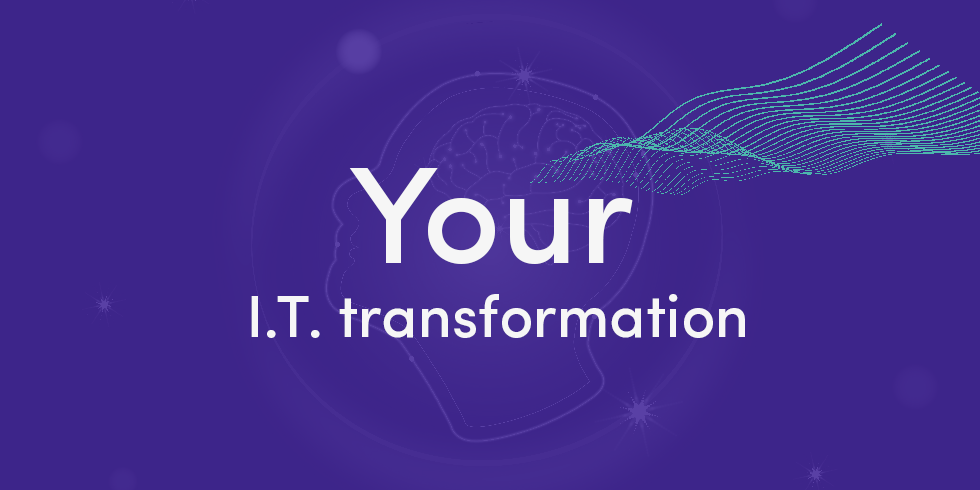10 Mind shifts needed for a great transformation
For too many years now, you have suffered budget cuts. Tired of looking your IT infrastructure grows stale. You understand the need for transformation, for modernizing. You are also aware that your current mindset must evolve for the environment to do so.
That is where we intervene. The goal is to transform not from your current environment but toward the future one.
Here are a few mind shifts necessary to ensure a successful transformation project.
1. Envision the end game before you start planning
You would never begin to build a house without a plan. Then why should your IT systems be any different?
Let’s apply a similar rule to your next-generation IT environment, shall we?
- Do you have a deep understanding of your mission-critical systems?
- What would distinguish you from your competitors in 5 years?
- How could you positively impact your users’ community, help them achieve more?
- Can your IT systems’ complexity and costs be highly reduced?
- Could you attract talents, become an innovation center where people are drawn to?
- How will you handle your company’s growth?
To put it bluntly, have you taken the time to set the vision and work on the plan to achieve it?
This vision definition has to come first. And yes, some people are all about system thinking and brainstorming. Excellent management means delegating to the person who has the talent.
2. The need to change management paradigms
This paradigms shift is a critical point.
It would help if you stopped going for the shiniest thing. Your technology environment cannot be a collection of bells and whistles. Let me rephrase that. It can, but it will not be secured, stable or manageable. In other words: It would be a mess.
Your users’ community must be educated on technology and overarching principles.
I often see requests sent saying “We need this technology” instead of “We have this need.” Your entire management has to be aware of the plan and how they can support it.
It does affect the overall strategy and induces unnecessary complexity.
Here’s a great example, we are finishing a blueprint for a customer. We have set rules of engagements, norms and they are ready to go with an execution plan. Talking to another vendor, I hear that they are selling them on this latest tool for data management. Of course, the said tool is entirely outside of the proposed suite.
There it is: Induced complexity.
There needs to be a hardstand. Reducing and simplifying your IT ecosystem is the only way to improve the quality of service. With the current talent shortage, you are not getting any more specialists. If you are lucky, you will not lose any.
Manage wisely.
3. Know your data intimately.
Before any cybersecurity architecture, you need to know the landscape. When it comes to IT systems, you need to classify data and the related systems they depend on. You may have an excellent backup of all your data, but if it relies on 5.25” floppies, you may be out of luck. The same is true for IT systems. There needs to be a sequence to recuperate data. That sequence must be guided by priority.
I have learned to create islands or enclaves of data with different levels of sensibility and criticality. This becomes the foundation for many services that need this categorization.
My favourite example to this day is with regards to a backup solution. Are you, as a company, putting the same value on the intern’s playlist as with your customer’s data? Or your patient’s x-rays? Of course not.
Then why are you willing to treat them as equals in front of your backup solution?
So before you invest thousands, perhaps millions of dollars in the evolution of your backup, get to know your data.
4. Cybersecurity has to become your foundation, not an afterthought
Once you have a cartography of your existing data and systems, planning can start. From there, you will be able to create a cyberdefense strategy.
How? Consider the cartography analogy. You have 10 square kilometres of land. On this, you know you have:
- A vault with all your priced belonging
- Te family’s home
- A well that provides you with water
- An old shed
- An abandoned hunting cache
What do you protect first and foremost? Obliviously not the old shed. And yes, you can set a perimeter wall, but what happens when the attack comes from within the perimeter? What then?
The same applies to your IT systems and your data. Should you lose everything, what do you recover first. What must not come down? What are their dependencies?
That is when you can start building a robust cybersecurity architecture.
5. Enable your team to create the future
I know that some companies like to bring in expert consultants to transform their IT. I have reservations about that model.
And don’t take me wrong, I have made a life out of transforming other peoples’ systems. So once again, I am going against dogma.
Here are a few points that push me in this direction. First, who knows how your company works inside/out? Your team, of course. They have been breathing your company’s way of doing things for the past years. They are obliviously more aware and knowledgeable of the overall systems, dependencies and people.
Who needs to know those environments inside/out to maintain them in the future? Then again, your IT team.
Then there is the fact of making things happen, having an impact, making a difference and contributing. There can’t be a monetary value attached to this. We are talking about valorizing your existing staff.
6. Your team has to become experts in the new technologies, and they need to lead the show
And yes, I can hear the argument: “but they don’t know anything about XYZ’s technology.” To this, I answer, “Who will be managing it at the end of the project? Who will need to become an expert on this technology?”. The answer is obliviously your IT team. So please take advantage of the transformation, have them lead the way and train them ahead of time. If they need support from people who have seen or done this many times, that is fine, but please, let them lead.
Then comes the oblivious reasoning that they currently have a job to do; they can’t do projects. It makes sense, but think about the following:
- Would a ten-year-old technology or the latest cloud open more opportunities in the future for them?
- If you keep them maintaining the older system, will they stay with you longer?
- If you don’t train them and encourage their development, are they more likely to seek opportunities?
You have to ensure that your staff is adequately challenged and has room to grow. They need the space and opportunities to make a difference. This will simultaneously reduce the cynism that plagues the workplace—that feeling of not contributing or making a difference.
7. The mind shift required in your procurement models
Your procurement teams have to lead your normalization efforts. They need to be on board with these new models.
If your various request for proposals (or RFPs) are not structured properly, this can derail your efforts.
Here’s an example:
- Say you want to purchase new servers to make your datacenter hybrid with the cloud;
- The RFP goes out and states all of your project’s requirements
- Someone complaints that your RFP does not accept his cloud platform. He states that it is unfair and favouring his competition;
- Your procurement looks at the rule book and tries to enlarge the scope to accommodate everyone.
Result: You now have a bridge to a cloud that you did not want. This is fictional, but the idea that the deciders do not own the overall plan can be frightening. You can have the best strategy to harmonize your technical portfolio and end with a pizza. With a lot of mixed ingredients. And just like that, you are back to square 1.
There needs to be a hard left shift to ensure that hard requirements backed by a plan are allowed. Not to be unfair or favour one party, but to ensure cohesion within the data center.
8. Centralizing your attention and efforts on the most critical asset: The human.
Once you sit back and look at all that you have planned, all you’ll be left with is: will it be useful? Will it be accepted and integrated?
What is the only way to make sure that this happens? Ensure that everyone who is going to use it is excited about it! Be clear about what it will mean for them, and get them properly trained.
The implementation team can be told what will be deployed and have that choice removed but have complete control of its deployment. This will give the team a sense of ownership. Even if they did not choose the brand and model, they could choose the colour and the options.
It is hard, but you need a constant reminder that you are doing this for fellow humans. Who will resist change but are all looking for a reason, just a little push, to get on board and push.
9. Define the intention behind your program and all projects
You need to figure out the why behind each project. Nobody does a Windows 10 upgrade project strictly to upgrade desktops and laptops.
So why do we do those projects? What is the intent?
Here are a few samples to get you going:
- Putting our patients at the heart of our transformation. To support our front-line team to achieve exceptional service, we have launched an initiative to modernize systems. This will allow for more excellent reliability, deepen security and simplify collaboration between teams.
- To improve the response time of our networking teams, we will be harmonizing some network equipment. This will positively impact the implementation velocity of any future transformation projects.
- To empower our technical champions in every department, we are enabling a community coding initiative. This will allow all who want to contribute to share their business knowledge. The IT department will provide the tools, training and data required to support any citizen developer within our company.
10. Implicate your users’ community
As we mentioned before, your users’ community will make or break your transformation project. They can lift you or create your life hell. So, which do you choose?
All jokes aside, they need to feel like they matter, to feel heard. To do so, you will need a robust change management presence within your project.
This implication is a crucial success factor. Without it, you are putting your investment at risk.
Each company has a culture, and just like in our neighbourhoods and our other communities, it can be influenced and educated. That requires work from specialists.
Those specialists are named: Change Management Specialists. Their functions are to communicate changes and to ensure that it is correctly perceived.
Conclusion
Before throwing Millions of dollars at transformation, we recommend that you take the proper time to think it through. I am sure many large consulting agencies will be more than happy to receive those Millions, but it may not be in your best interests.
What does this future vision hold for you, and how it should be is what’s at stake? Make sure you choose your trusted advisor wisely.
Have a great week!

